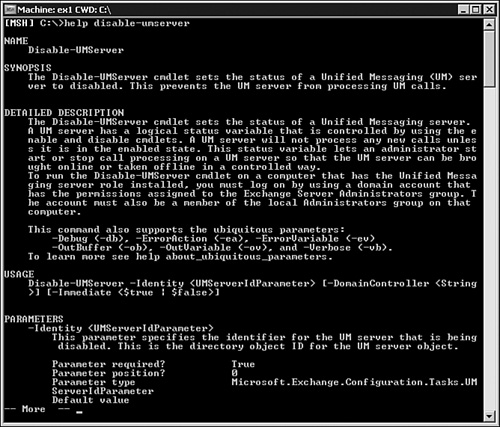Sometimes, just finding
commands in the Exchange Management Shell can be a daunting task. In
this section, each of the unified messaging commands is listed by verb.
For each of the commands, the detailed syntax can be obtained by executing the command help cmdlet. For example, to get help on the cmdlet Add-ADPermission, execute the command help adpermission in the Exchange Management Shell interface shown in Figure 1.

Add/Remove Verb Cmdlets
Table 1 lists all the Exchange 2007 unified messaging specific add/remove verb cmdlets.
Table 1. Add/Remove Cmdlets
| Verb | Noun | Cmdlet Name |
|---|
| Add | ADPermission | Add-ADPermission |
| Add | ExchangeAdministrator | Add-ExchangeAdministrator |
| Remove | ADPermission | Remove-ADPermission |
| Remove | UMAutoAttendant | Remove-UMAutoAttendant |
| Remove | UMDialPlan | Remove-UMDialPlan |
| Remove | UMHuntGroup | Remove-UMHuntGroup |
| Remove | UMIPGateway | Remove-UMIPGateway |
| Remove | UMMailboxPolicy | Remove-UMMailboxPolicy |
Get/Set Verb Cmdlets
Table 2 lists all the Exchange 2007 unified messaging specific get/set verb cmdlets.
Table 2. Get/Set Cmdlets
| Verb | Noun | Cmdlet Name |
|---|
| Get | ADPermission | Get-ADPermission |
| Get | UMActiveCalls | Get-UMActiveCalls |
| Get | UMAutoAttendant | Get-UMAutoAttendant |
| Get | UMDialPlan | Get-UMDialPlan |
| Get | UMHuntGroup | Get-UMHuntGroup |
| Get | UMIPGateway | Get-UMIPGateway |
| Get | UMMailbox | Get-UMMailbox |
| Get | UMMailboxPIN | Get-UMMailboxPIN |
| Get | UMMailboxPolicy | Get-UMMailboxPolicy |
| Get | UmServer | Get-UmServer |
| Set | EventLogLevel | Set-EventLogLevel |
| Set | UMAutoAttendant | Set-UMAutoAttendant |
| Set | UMDialPlan | Set-UMDialPlan |
| Set | UMIPGateway | Set-UMIPGateway |
| Set | UMMailbox | Set-UMMailbox |
| Set | UMMailboxPIN | Set-UMMailboxPIN |
| Set | UMMailboxPolicy | Set-UMMailboxPolicy |
| Set | UmServer | Set-UmServer |
Test Verb Cmdlets
Table 3 lists all the Exchange 2007 unified messaging specific test verb cmdlets.
Table 3. Test Cmdlets
| Verb | Noun | Cmdlet Name |
|---|
| Test | SystemHealth | Test-SystemHealth |
| Test | UMConnectivity | Test-UMConnectivity |
Enable/Disable Verb Cmdlets
Table 4 lists all the Exchange 2007 unified messaging specific enable/disable verb cmdlets.
Table 4. Enable/Disable Cmdlets
| Verb | Noun | Cmdlet Name |
|---|
| Enable | UMAutoAttendant | Enable-UMAutoAttendant |
| Enable | UMIPGateway | Enable-UMIPGateway |
| Enable | UMMailbox | Enable-UMMailbox |
| Enable | UMServer | Enable-UMServer |
| Disable | UMAutoAttendant | Disable-UMAutoAttendant |
| Disable | UMIPGateway | Disable-UMIPGateway |
| Disable | UMMailbox | Disable-UMMailbox |
| Disable | UMServer | Disable-UMServer |
Copy Verb Cmdlet
Table 5 lists the only Exchange 2007 unified messaging specific copy verb cmdlet.
Table 5. Copy Cmdlet
| Verb | Noun | Cmdlet Name |
|---|
| Copy | UMCustomPrompt | Copy-UMCustomPrompt |
New Verb Cmdlets
Table 6 lists all the Exchange 2007 unified messaging specific new verb cmdlets.
Table 6. New Cmdlets
| Verb | Noun | Cmdlet Name |
|---|
| New | UMAutoAttendant | New-UMAutoAttendant |
| New | UMDialPlan | New-UMDialPlan |
| New | UMHuntGroup | New-UMHuntGroup |
| New | UMIPGateway | New-UMIPGateway |
| New | UMMailboxPolicy | New-UMMailboxPolicy |